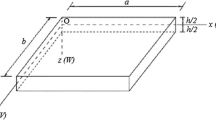Abstract
A connection between Cheng's refined theory and Gregory's decomposed theorem is analyzed. The equivalence of the refined theory and the decomposed theorem is given. Using operator matrix determinant of partial differential equation, Cheng gained one equation, and he substituted the sum of the general integrals of three differential equations for the solution of the equation. But he did not prove the rationality of substitute. There, a whole proof for the refined theory from Papkovich-Neuber solution was given. At first expressions were obtained for all the displacements and stress components in term of the midplane displacement and its derivatives. Using Lur'e method and the theorem of appendix, the refined theory was given. At last, using basic mathematic method, the equivalence between Cheng's refined theory and Gregory's decomposed theorem was proved,i. e., Cheng's bi-harmonic equation, shear equation and transcendental equation are equivalent to Gregory's interior state, shear state and Papkovich-Fadle state, respectively.
Similar content being viewed by others
References
Cheng Shun. Elasticity theory of plates and a refined theory[J].Journal of Application Mechanics, 1979,46(2): 644–650.
Lur'e A I.Three-Dimensional Problems in the Theory of Elasticity[M]. Interscience New York, 1964, 148–166.
Wang Feiyue. A refined elasticity theory for transversely isotropic plates[J].Shanghai Mechanics, 1985,6(2): 10–21 (in Chinese).
Gregory R D. The general form of the three-dimensional elastic field inside an isotropic plate with free faces[J].Journal of Elasticiy, 1992,28(1): 1–28.
Gregory R D. The semi-infinite stripx≥0, −1≤y≤1; completeness of the Papkovich-Fadle eigenfunctions whenφ xx(0,y),φyy(0,y) are prescribed[J].Journal of Elasticity, 1980,10(1): 57–80.
Gregory R D. The traction boundary value problems for the elastostatic semi-infinite strip; existence of solution, and completeness of the Papkovich-Fadle eigenfunctions[J].Journal of Elasticity, 1980,10(3): 295–327.
Wang Minzhong, Zhao Baosheng. The decomposed form of the three-dimensional elastic plate[J].Acta Mechanica, 2003,166(3): 207–216.
Zhao Baosheng, Wang Minzhong. The decomposed theorem of the transversely isotropic elastic plate[J].Acta Mechanica Sinica, 2004,36(1): 57–63 (in Chinese).
Wang Minzhong, Wang Wei. Completeness and nonuniqueness of general solutions of transversely isotropic elasticity[J].International Journal of Solids and Structures, 1995,32(3/4): 501–513.
Wang Wei, Wang Minzhong. Constructivity and completeness of the general solutions in elastodynamics[J].Acta Mechanica, 1992,91(1): 209–214.
Wang Wei, Shi Mingxing. Thick plate theory based on general solutions of elasticity[J].Acta Mechanica, 1997,123(1): 27–36.
Author information
Authors and Affiliations
Corresponding author
Additional information
Communicated by DING Hao-jiang
Project supported by the National Natural Science Foundation of China (Nos. 10172003 and 10372003) and the Doctoral Foundation of Education Ministry of China (No. 2000000112)
Rights and permissions
About this article
Cite this article
Bao-sheng, Z., Min-zhong, W. Equivalence of refined theory and decomposed theorem of an elastic plate. Appl Math Mech 26, 486–494 (2005). https://doi.org/10.1007/BF02465388
Received:
Revised:
Issue Date:
DOI: https://doi.org/10.1007/BF02465388




